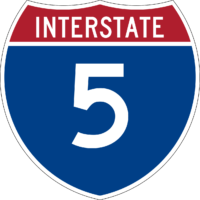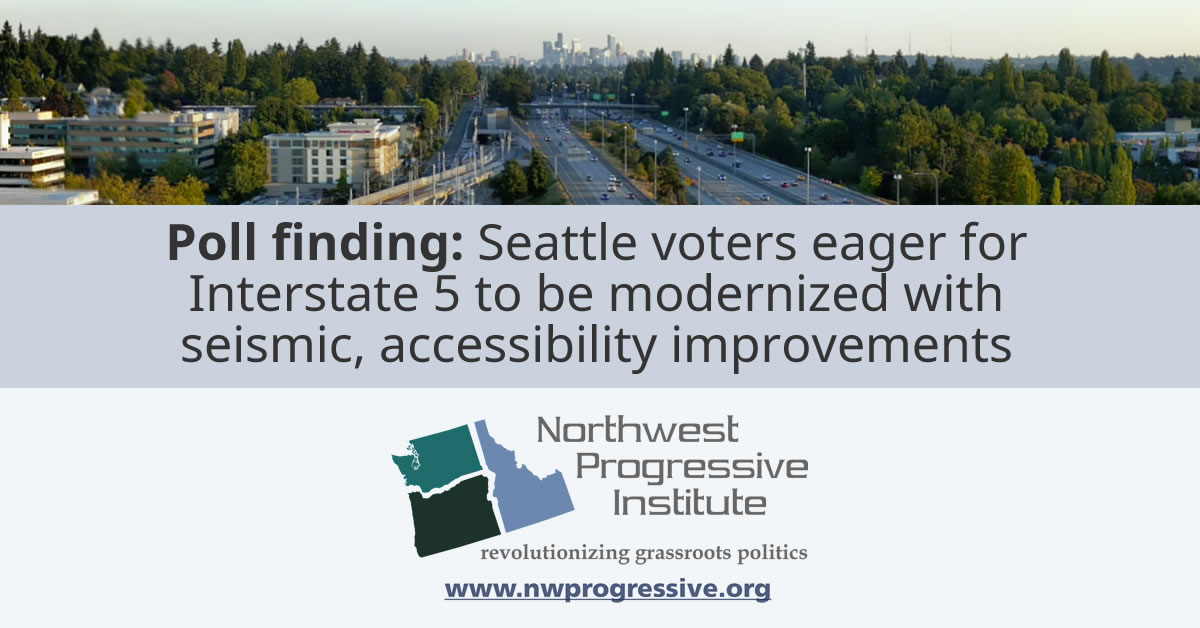Six decades ago, the Washington State Department of Transportation (WSDOT) set up an office to begin clearing land for the “Seattle Freeway,” a massive project intended to create new right of way for automobile traffic through the city’s central core along with the neighborhoods to the north and south of it.

Over the span of several years, construction crews relocated or demolished thousands of structures on 4,500 parcels of land, literally splitting the city in half in the process.
The result was a twenty and a half mile artery for automobiles stretching from one edge of the city to another.
However, it would not be known as the “Seattle Freeway,” nor would it be signed with a traditional state or “U.S.” route number, for Congress and President Eisenhower had agreed in the late 1950s on legislation to create a new interstate highway system for the United States.
It would take a couple more decades, but by the end of the 1970s, Interstate 5’s initial buildout was complete. Designated by Congress as the main north-south route serving the United States’ Left Coast, Interstate 5 is the only highway that goes from the Canadian border at its northern end all the way to the Mexican border at its southern end, with a length of 1,381.29 miles/2,222.97 kilometers.
I‑5’s Seattle section is among its busiest. The twenty-mile Emerald City segment nowadays sees levels of traffic that would have been unimaginable in the 1950s when it was designed. The same is true of I‑5 segments in other metropolitan areas, like Los Angeles or Portland, where I‑5 crosses the Columbia River.
Despite I‑5’s importance to Seattle, Washington, and the Pacific Northwest, it is falling apart. Decades of heavy use and inadequate maintenance have left the highway in increasingly bad shape. The Washington State Department of Transportation, aware of the need for action, has responded with a series of legislatively-authorized projects that it collectively calls “Revive I‑5″.
“Completing this critical preservation work will take more than a decade, into the 2030s,” WSDOT explains on its project website, referring to the difficulty of working on the highway while also keeping it open to traffic.
“Managing traffic and congestion during pavement preservation work requires careful and coordinated planning that considers time of year, regional special events, changes to the transit system and other state or local road closures. All scheduled lane and ramp closures for these preservation projects are carefully timed. However, emergency repairs could happen at any time. Scheduled work reduces the chances that an incident requiring emergency repairs may occur.”
As with the State Route 520 floating bridge replacement project and Alaskan Way Viaduct replacement tunnel project, WSDOT is in a race against the clock. Washington State is earthquake country and a temblor could strike at any time, with little to no warning, causing massive damage to I‑5 and other infrastructure.
While I‑5’s integrity and future is often discussed at state, county, or city transportation committee work sessions and at WSDOT staff meetings, it gets far less attention than it should in the press and in other settings.
As part of our July 2021 survey of the Emerald City electorate, we decided to ask Seattle voters a series of questions about Interstate 5 earlier this summer to ascertain their awareness of the facility’s seismic risks and access improvement needs, and their enthusiasm for modernizing the highway.
First, we asked about awareness of I‑5’s vulnerability to quakes. We included a map with our question showing highways in King County, I‑5 included, that are critical to regional mobility and at risk of earthquake damage. We asked respondents how concerned they are about I‑5’s resilience, and found that the vast majority of Seattle voters are either somewhat or very concerned.
QUESTION: The map below depicts the state of risk of major highways in our area to severe damage in a major earthquake. After reviewing the map, please indicate how concerned you are about the capability of Interstate 5 to survive a major earthquake in Seattle and be available for emergency use.
ANSWERS:
- Concerned: 82%
- Very concerned: 38%
- Somewhat concerned: 44%
- Not worried: 13%
- Not worried: 10%
- Not worried at all: 3%
- Unsure: 5%
Note: The map above has been updated slightly for clarity in preparation for public dissemination since the poll fielded in mid-July, but is otherwise identical to the version that poll respondents saw when taking the survey.
Over eight in ten voters described themselves as concerned, versus just 13% who stated they were not worried. Only 5% said they were unsure.
Most Seattleites clearly appreciate that I‑5 is at risk of failure in an earthquake, which is not surprising, but nevertheless reassuring.
Next, we asked voters about improving I‑5’s flow through Seattle’s downtown and First Hill neighborhoods. In particular, we wanted to know how voters would react to the idea of relocating some of the numerous entry and exit ramps that make this section of the highway needlessly treacherous to navigate.
We found plenty of enthusiasm:
QUESTION: The map below shows the entry and exit ramps to Interstate 5 in downtown Seattle.
After reviewing the map, please specify whether you would support or oppose relocating some of the Interstate 5 ramps in downtown Seattle if this were determined to be feasible for improving traffic congestion and safety issues.
ANSWERS:
- Support: 77%
- Strongly support: 43%
- Somewhat support: 34%
- Oppose: 12%
- Somewhat oppose: 6%
- Strongly oppose: 6%
- Unsure: 6%
Note: The map above has been updated slightly for clarity in preparation for public dissemination since the poll fielded in mid-July, but is otherwise identical to the version that poll respondents saw when taking the survey.
More than three-fourths of respondents indicated support for relocating ramps.
Finally, we asked respondents to weigh in on I‑5’s future in their own words.
We offered the following as a question prompt:
QUESTION: Should the state prioritize modernizing the stretch of Interstate 5 that runs through Seattle, from the northern city limit with Shoreline to the southern city limit with Tukwila?
ANSWERS:
- 40% wrote supportive answers
- 30% did not express a clear stance or made other comments
- 18% indicated opposition
- 12% expressed ambivalence or said they didn’t know
The plurality who wrote supportive answers expressed a lot of enthusiasm.
“100% would support modernizing the stretch of I‑5. It’s been a huge problem with traffic and for people commuting to and out of Seattle,” wrote one.
“I‑5 is in such bad shape and negatively dissects the city,” noted another. “It needs to be redone to better serve travelers, reunite neighborhoods it now divides and be climate neutral.”
“Definitely need [I‑5 to be] more transit ready and earthquake safe,” agreed yet another respondent. “Single car driving should be discouraged and the city needs to greatly improve mass transit.”
A fourth wrote: “The state absolutely needs to prioritize this project. The area is so congested at nearly all times of the day. It needs to be made safer also by making sure people can’t throw items from the overpasses onto cars below.”
“I would take pride in Seattle if it was one of the only cities in America to actually have its infrastructure up to and safer than code,” said a fifth, who identified themselves as a young Seattleite. “Making it more transit friendly may be worth it, but upgrading it so it’s safer than America’s bridges generally is vital.”
Many of the small number in opposition suggested it simply wasn’t feasible.
“At this point just wait for the quake it will happen before any construction project could ever be completed,” one respondent said.
“Can’t do everything,” wrote another.
“I do not consider this a priority. We have more, serious issues that need greater attention, urgency, and funding than creating more convenience on our freeways,” said a third, apparently having interpreted “modernization” to mean “widening”.
Other respondents called for fixing the West Seattle Bridge first. (SDOT currently expects to partially reopen the bridge to traffic next year.)
And still other respondents expressed interest in how WSDOT would do the work without creating additional traffic problems for I‑5 users.
“How will you minimize duration and severity of traffic disruptions during this modernization process?” one respondent wondered. “I‑5 in Tacoma has been under continuous construction for 10+ years.”
(WSDOT actually has a pretty detailed traffic mitigation plan for the work it’s already got funding to do, which is one reason why the work has such a long timeframe. Still, as with all construction projects, there will be disruptions.)
Our poll of 617 likely August 2021 Seattle voters was in the field through Monday, July 12th, through Thursday, July 15th. All respondents participated online. The poll was conducted by Change Research for the Northwest Progressive Institute, and has a modeled margin of error of 4.3% at the 95% confidence interval.
One of the themes running through the open-ended responses was a desire for more and better transit. Even though our prompt was about modernizing I‑5, quite a few respondents spoke of wanting to finish building out Sound Transit’s Link light rail system and pursue policies that reduce automobile dependence.
That’s fresh and useful evidence that Seattleites understand that an auto-centric transportation system is neither sustainable or desirable.
The future is multimodal. Better transit will liberate the Emerald City from car dependence, enabling more and more trips to be taken by walking, bicycling, riding the bus or train, or a combination of all three. With that said, respondents do agree that we must invest in I‑5’s future. Making the highway seismically safe will improve our ability to recover from a major disaster and will protect all users of the highway, including those in buses as well as cars and trucks.
Only a fraction of what is needed to fully modernize I‑5 has been appropriated so far by the Legislature. Lawmakers are currently contemplating authorizing more funds for I‑5 by enacting a new transportation package that would build on the investments approved in Connecting Washington six years ago.
Meanwhile, Democrats in Congress are trying to reach agreement on legislation requested by President Joe Biden that would make major investments in infrastructure along with America’s social contract. If those efforts succeed, I‑5 will almost certainly be one of the facilities that benefits.



